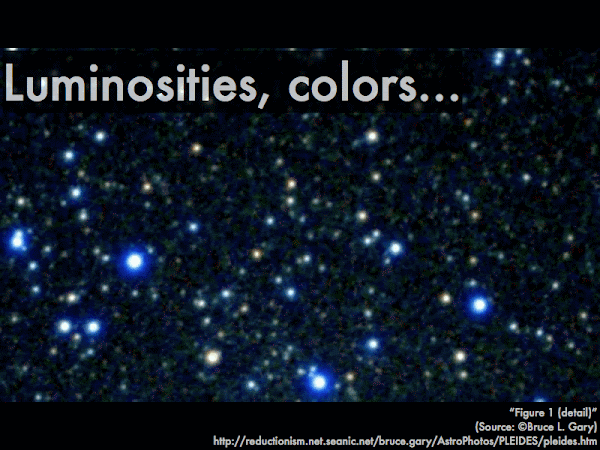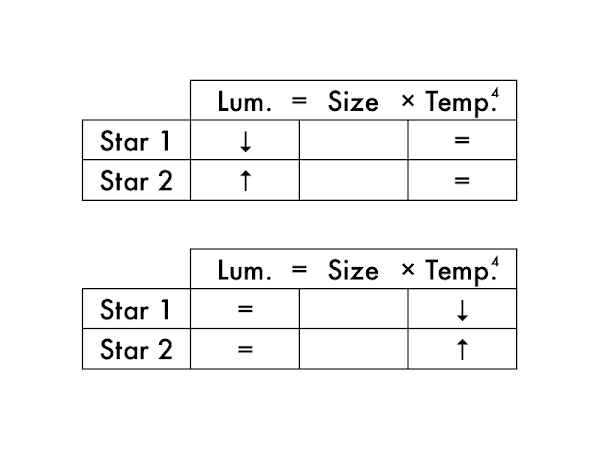Cuesta College, San Luis Obispo, CA
Students have a weekly online reading assignment (hosted by SurveyMonkey.com), where they answer questions based on reading their textbook, material covered in previous lectures, opinion questions, and/or asking (anonymous) questions or making (anonymous) comments. Full credit is given for completing the online reading assignment before next week's lecture, regardless if whether their answers are correct/incorrect. Selected results/questions/comments are addressed by the instructor at the start of the following lecture.
The following questions were asked on reading textbook chapters and previewing presentations on parallax, distance, apparent magnitude, absolute magnitude, Wien's law and the Stefan-Boltzmann law.

Selected/edited responses are given below.
Describe something you found interesting from the assigned textbook reading or presentation preview, and explain why this was personally interesting for you.
"The size of the earth's orbit is the baseline to find the distance to a star. Makes sense since it gathers information when Earth is at either end of its orbit!"
"Parsecs, because now I know what Han Solo meant when he said the Millennium Falcon could complete the Kessel Run in less than 12 parsecs."
"I found the large difference between the apparent and absolute magnitude of the Sun to be very interesting. It's weird how the sun is actually dimmer then many stars, but it appears brighter because it is closer."
"I found how they ranked the brightness of the stars to be very interesting. Loved how you put it in perspective of how the Greeks used a similar ranking system. of 1st place through 6th place. Because you were right. At first looking at the numbers, it was confusing when seeing –27 through +6."
"The temperature of stars, red stars are cool and blue stars are hot. logically that is backward as red is related to hot and blue to cold."
"I always assumed white was the hottest star. I know beauty is in the eye of the beholder, but it's weird to be proven wrong."
"I found interesting that blue stars are hotter than orange or red stars. In a chemistry class years ago, we were told that the blue part is the hottest in a flame and I guess that would apply to other things in the universe. I shouldn't have been surprised that the same is true for stars."
"I found color to size ratios interesting because I never thought of a small, hot star and a large, cool star having the same luminosity."
"It was interesting to learn that white dwarf stars are around the same size as earth. I previously didn't know any stars were that small."
Describe something you found confusing from the assigned textbook reading or presentation preview, and explain why this was personally confusing for you.
"The labeling of the brightnesses were weird to get used to but honestly not that bad."
"What the differences between absolute and apparent magnitude mean."
"The temperatures of the sequence stars was especially confusing to me. The diagram in the chapters didn't help me at all, I couldn't figure out how to read the diagram. (Edit: After reading your presentation and looking at the diagram you gave, it made a lot more sense to me!)"
"I found that the luminosity equals size times temperature4 to be somewhat confusing. I am hoping we can work on some more problems that would help me understand those a little bit better and how to classify the stars."
"Star sizes relative to their temperature and color. it was confusing because i didn't have enough time to go over the slide."
"The dwarf stars and supergiants and main-sequence stars; I didn't quite grasp what those phrases meant as far as temperature."
"I found this section quite easy to follow in all honesty."
Explain how apparent magnitude and the absolute magnitude are defined differently.
"Apparent magnitude is how the star looks from earth, while absolute is how it really is."
"Apparent measures a stars brightness based on how they seem to us without taking into account how far away the star is. Absolute magnitude takes into account the distance."
"Apparent magnitude is how bright a star appears to you on Earth. Absolute magnitude is when you know the distance and use math to calculate how bright a star would be at 10 parsecs away."
"Absolute magnitude is a standard measure (10pc) used to compare stars because their different distances from us change their appearance. Apparent magnitude is how bright the star looks to you on earth and doesn't take into consideration the distance from you or other stars you are comparing it to."
"Apparent is as seen by an observer on earth and is not an accurate way to measure brightness of stars, absolute helps to see when stars are actually dimmer."
"Unsure/guessing/lost/help! I understand the brightness of a star, but I'm not sure I really grasp the difference between apparent magnitude and absolute magnitude."
Suppose the sun was moved to a distance of 10 parsecs away. As a result, its __________ magnitude would become dimmer.
absolute. ******* [7] apparent. *********** [11] (Both of the above choices.) * [1] (Neither of the above choices.) * [1] (Unsure/guessing/lost/help!) [0]

(Only correct responses shown.)
1 (brightest): the sun, m = –27 [80%]
2: Canopus, m = –1 [75%]
3: Vega, m = 0 [85%]
4 (dimmest): Kapteyn's star, m = +9 [75%]
Rank the brightnesses of these stars (1 = brightest, 4 = dimmest; there are no ties), if relocated to 10 parsecs from Earth.
(Only correct responses shown.)
1 (brightest): Canopus, M = –3 [70%]
2: Vega, M = +0.5 [80%]
3: the sun, M = +5 [75%]
4 (dimmest): Kapteyn's star, M = +11 [75%]
Determine whether these stars get dimmer or brighter when relocated from their original positions to 10 parsecs from Earth.
(Only correct responses shown.)
The sun: gets dimmer [75%]
Canopus: gets brighter [70%]
Vega: gets dimmer [65%]
Kapteyn's star: gets dimmer [65%]
Rank the temperatures of these main sequence stars (1 = hottest, 4 = coolest; there are no ties).
(Only correct responses shown.)
Hottest: blue main sequence star [75%]
Second hottest: white main sequence star [60%]
Third hottest: yellow main sequence star [80%]
Coolest: red main sequence star [75%]
Rank the temperatures of these supergiant and dwarf stars (1 = hottest, 4 = coolest; there are no ties).
(Only correct responses shown.)
Hottest: blue supergiant [75%]
Second hottest: white dwarf [60%]
Third hottest: yellow supergiant [75%]
Coolest: red dwarf [75%]

dimmer. **** [4] brighter. *************** [15] (These stars would be the same size.) [0] (Unsure/guessing/lost/help!) * [1]
Two stars (equally far away) have the same brightness, but one star is cooler, and the other star is hotter. The __________ star will be larger in size.
cooler. ********* [9] hotter. ********* [9] (These stars would be the same size.) ** [2] (Unsure/guessing/lost/help!) [0]
Ask the instructor an anonymous question, or make a comment. Selected questions/comments may be discussed in class.
"I will start implementing new study techniques soon."
"Does the location of our solar system in the universe matter? If our whole solar system was moved, could the conditions of the surrounding universe make everything unstable?" (Yes, especially if we had closer neighboring stars, they could disrupt the cloud of comets surrounding the sun at the very edge of our solar system, making it much impact events on Earth much more frequent.)
I asked my parents where baby planets come from, and they said. When a daddy star and a mommy star fall in love, there is some really hot action. Then their babies get thrown all over the place. Is this true?" (We'll look at the "birds and the bees" of how stars are born next week.)
"How can we know how big stars are?" (We'll talk about this specifically on Thursday. Short answer: you calculate the size from measurements of their brightness and color.)
"I'm confused about white dwarfs. They are white which make me think they are hot, but they are dying, so are they cooler than other white stars?" (They are white and very hot, but yes, they are dying in the sense that they no longer can produce energy. So a fresh white dwarf will be white-hot, but will gradually cool off (over a very, very long time) and to become a cooler "black dwarf." However, this process takes such a long time that no white dwarf has yet to become a black dwarf, as they manage to hold on to their heat really well.)
"Between the two Cuesta campuses, is one better than the other for using the telescopes in regards to light pollution, turbulence, etc.?" (North County campus is better in terms of having less light pollution (although the new building may change that), and especially better in terms of not having the marine fog layer roll overhead on most nights.)
"Could please briefly go over the parsecs, apparent and absolute magnitude, and how to find out which star is brightest/how to find out if it's brightest at 10 parsecs? I can't figure out how to calculate these things." (Yes, we will go over those things.)
"Stars are badass :)"
"It's kind of driving me crazy that our homework is further ahead than our quizzing...I am comfortable at the pace we are moving along with the homework but I would have an easier time if the quizzes were current with the reading/homework." (This is somewhat deliberate in order to give you enough time after seeing the material in class to go over it again before the quiz. But be careful of what you wish for--the cycle between homework and quizzes will get shorter as the end of the semester approaches.)
"In math, negative numbers are always smaller that positive numbers. When it comes to stars brightness, why do stars with negative numbers have a greater brightness than stars with positive numbers?" (Because stars were ranked like runners in a race, where "1st place" is better (brighter) than "2nd place," etc. Or like in a judged contest where "grand prize" is better than "1st runner up," "1st runner up" is better than "2nd runner up," etc. (So would that make the "grand prize" the "zero runner up?"))
"I feel like when I read the material in the book I am confused often. But when I look at your blogs it makes more sense and appears more practical to understand."
No comments:
Post a Comment